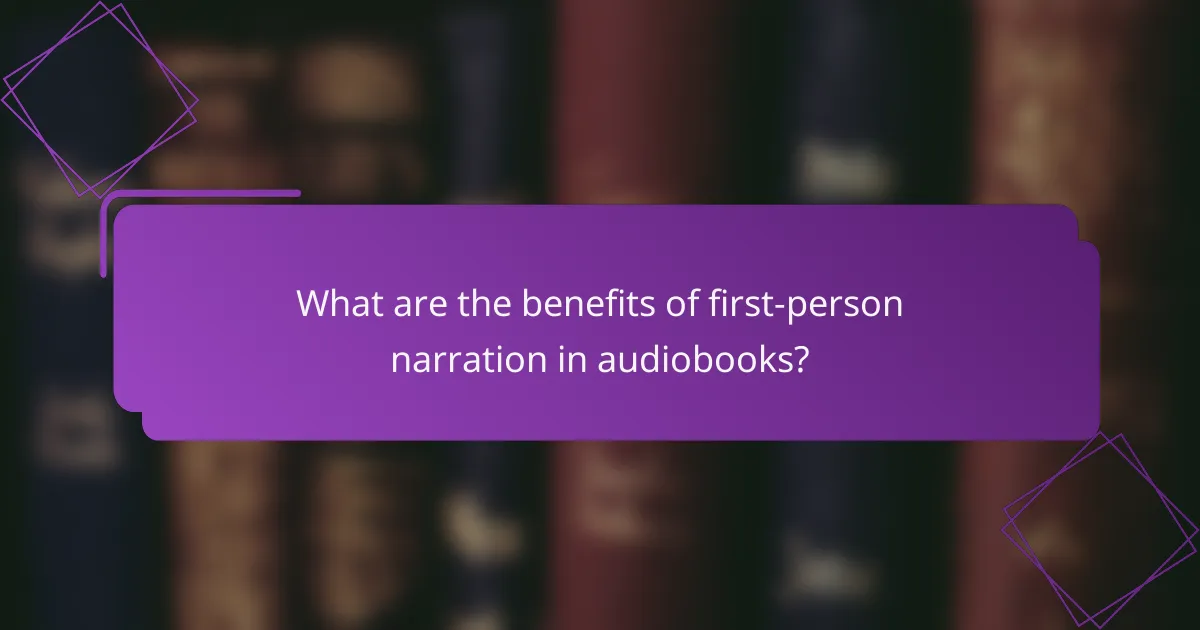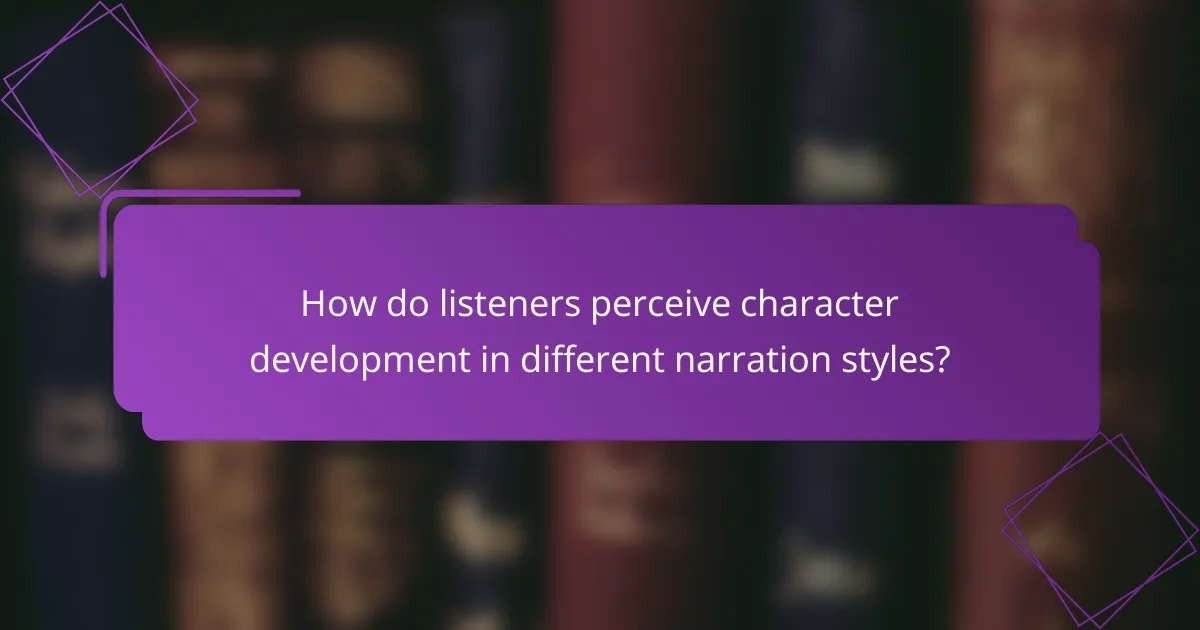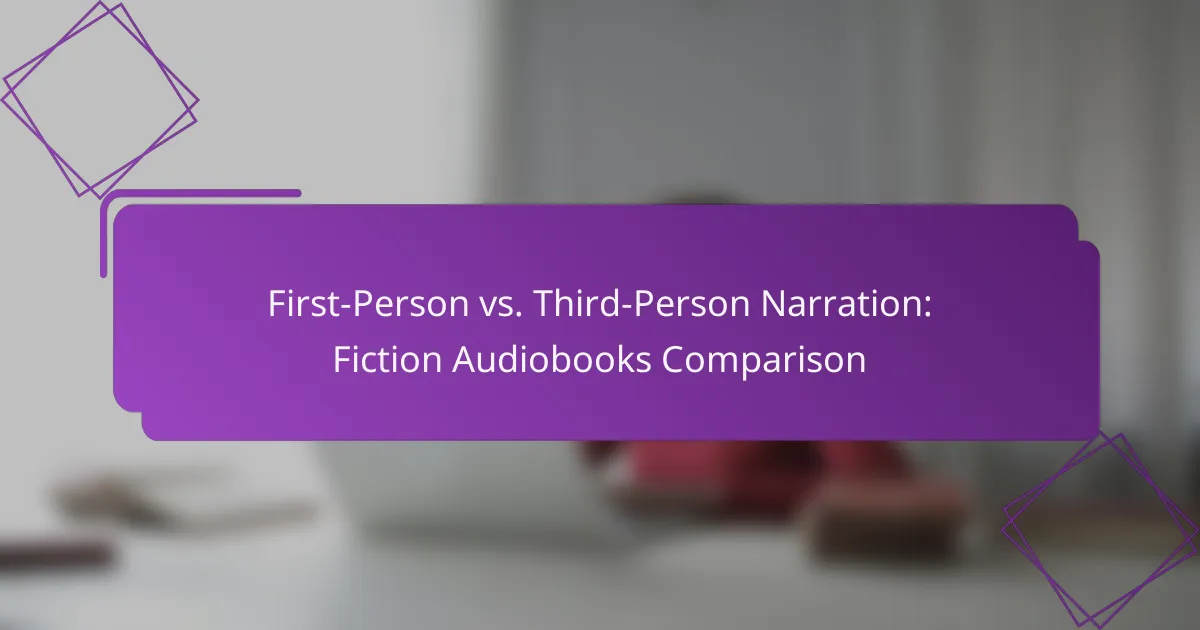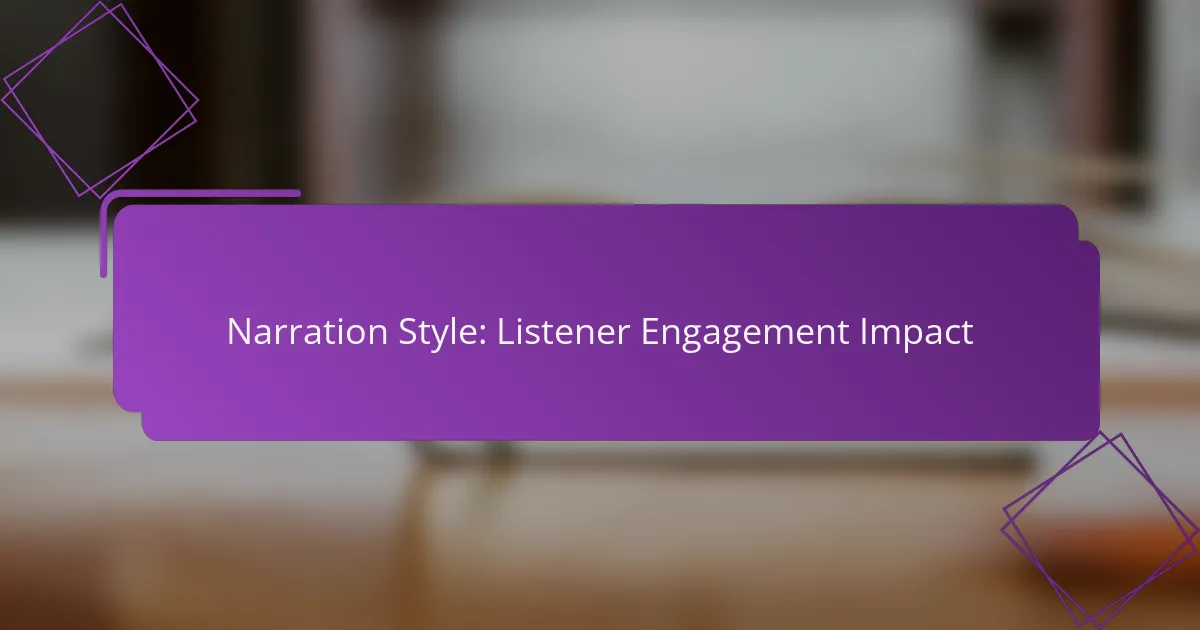First-person and third-person narration in fiction audiobooks create distinct listening experiences that cater to different preferences. While first-person narration immerses listeners in a character’s intimate thoughts and emotions, third-person narration provides a broader perspective, encompassing multiple characters and events. The choice between these styles can significantly influence the engagement and relatability of the story for the audience.

How do first-person and third-person narration differ in fiction audiobooks?
First-person and third-person narration in fiction audiobooks create distinct listening experiences. First-person narration immerses listeners in a character’s personal thoughts and feelings, while third-person narration provides a wider view of the story, encompassing multiple characters and events.
First-person narration provides personal insight
First-person narration allows listeners to experience the story through the eyes of a single character, often using “I” or “we.” This style creates an intimate connection, as the audience hears the character’s inner thoughts, emotions, and motivations directly. It can evoke strong empathy and engagement with the character’s journey.
However, this perspective can limit the overall understanding of the plot, as listeners only receive information that the narrator knows. This can create suspense or mystery, but may also leave out crucial details about other characters or events.
Third-person narration offers broader perspectives
Third-person narration uses “he,” “she,” or “they,” allowing the narrator to describe events from an outside viewpoint. This style can be omniscient, providing insights into multiple characters’ thoughts and feelings, or limited to one character’s perspective. This flexibility enables a more comprehensive understanding of the story’s context and dynamics.
While third-person narration can sometimes feel less personal than first-person, it allows for richer world-building and character development. Listeners can appreciate the interplay between various characters and their motivations, leading to a more layered narrative experience.
Examples of popular audiobooks in each style
Popular audiobooks that utilize first-person narration include “The Catcher in the Rye” by J.D. Salinger and “The Fault in Our Stars” by John Green. These works draw listeners into the protagonists’ thoughts and feelings, making their experiences feel immediate and relatable.
In contrast, notable examples of third-person narration are “The Great Gatsby” by F. Scott Fitzgerald and “Harry Potter” series by J.K. Rowling. These audiobooks provide a broader view of the story, allowing listeners to explore the complexities of multiple characters and their interactions within the narrative.

Which narration style is more engaging for listeners?
First-person narration tends to create a more intimate experience for listeners, while third-person narration offers a broader perspective by incorporating multiple viewpoints. The choice between these styles can significantly impact how engaging an audiobook feels to its audience.
First-person narration creates intimacy
First-person narration immerses listeners in the protagonist’s thoughts and emotions, fostering a deep connection. This style allows the audience to experience the story through the eyes of a single character, making their journey feel personal and relatable.
For example, in a first-person narrated audiobook, the listener hears the character’s internal monologue, which can evoke empathy and understanding. This intimacy can be particularly effective in genres like memoirs or personal stories, where emotional engagement is crucial.
Third-person narration allows for multiple viewpoints
Third-person narration provides a broader scope by allowing the listener to access the thoughts and feelings of multiple characters. This style can enhance the complexity of the story, as it presents various perspectives and motivations, enriching the narrative experience.
In a third-person narrated audiobook, listeners can switch between characters, gaining insight into their individual struggles and triumphs. This approach works well in epic tales or ensemble casts, where understanding the dynamics between characters adds depth to the story.

What are the benefits of first-person narration in audiobooks?
First-person narration in audiobooks offers a deeply immersive experience, allowing listeners to connect intimately with the narrator’s thoughts and feelings. This perspective can enhance engagement and make the story more relatable, as it often reflects personal experiences and emotions.
Enhanced emotional connection
First-person narration fosters a strong emotional bond between the listener and the narrator. By sharing personal insights and vulnerabilities, the narrator invites the audience into their inner world, creating a sense of intimacy. This connection can evoke empathy and make the listener feel as if they are part of the story.
For instance, when a character recounts a moment of heartbreak or joy, listeners can resonate with those emotions, often reflecting on their own experiences. This emotional depth can lead to a more memorable and impactful listening experience.
Unique voice and style
A first-person narrative often showcases a distinct voice and style that can set the tone for the entire audiobook. The narrator’s personality shines through their storytelling, making the experience unique. This individuality can captivate listeners and keep them engaged throughout the story.
Moreover, first-person narration allows for creative language and colloquialisms that reflect the character’s background, enhancing authenticity. For example, a young adult protagonist might use contemporary slang, while an older character might employ a more formal tone, enriching the narrative and making it more relatable to different audiences.

What are the benefits of third-person narration in audiobooks?
Third-person narration in audiobooks offers a broader perspective, allowing listeners to engage with multiple characters and their experiences. This narrative style enhances the storytelling by providing insights into various viewpoints, which can create a richer, more immersive experience.
Comprehensive storytelling
Third-person narration enables comprehensive storytelling by presenting a wider scope of events and character interactions. This perspective allows the narrator to weave together various plotlines and subplots, giving listeners a fuller understanding of the narrative landscape.
For example, in a mystery audiobook, third-person narration can shift between the detective’s thoughts and the suspect’s actions, building tension and intrigue. This multifaceted approach keeps listeners engaged and invested in the outcome.
Flexibility in character development
Third-person narration provides flexibility in character development, allowing authors to explore multiple characters in depth. This style enables the exploration of each character’s motivations, backgrounds, and conflicts, which can enhance emotional connections with the audience.
Listeners can gain insights into a character’s internal struggles and relationships without being limited to a single perspective. This can be particularly effective in genres like fantasy or historical fiction, where diverse character arcs enrich the overall narrative.

How do listeners perceive character development in different narration styles?
Listeners often perceive character development differently based on whether a story is narrated in the first-person or third-person style. First-person narration tends to create a more intimate connection with the character, while third-person narration allows for a broader understanding of multiple characters and their interactions.
First-person offers deep character insight
First-person narration immerses listeners in the protagonist’s thoughts and feelings, providing a unique perspective on their motivations and struggles. This style fosters a strong emotional bond, as listeners experience events directly through the character’s eyes.
For example, in a first-person audiobook, the narrator’s tone and inflection can convey the character’s emotional state, enhancing the listener’s understanding of their internal conflicts. This deep insight can lead to a more personal and engaging experience, particularly in character-driven stories.
Third-person provides a wider character landscape
Third-person narration allows listeners to explore a broader range of characters and their relationships, offering a more comprehensive view of the story’s world. This style can shift focus between characters, providing context that enriches the narrative.
In a third-person audiobook, listeners may gain insights into multiple characters’ thoughts and feelings, which can create a more complex and layered understanding of the plot. This approach is particularly effective in ensemble casts or stories with intricate subplots, as it helps listeners appreciate the dynamics between characters.

What are some popular fiction audiobooks with first-person narration?
First-person narration in audiobooks provides an intimate perspective, allowing listeners to experience the story through the eyes of the protagonist. Popular titles often feature strong character voices and emotional depth, enhancing the overall listening experience.
The Catcher in the Rye by J.D. Salinger
This classic novel is narrated by Holden Caulfield, a teenager who shares his thoughts and experiences in a candid and relatable manner. The first-person perspective allows listeners to connect deeply with Holden’s struggles and emotions, making the story feel personal and immediate.
When listening to this audiobook, pay attention to the nuances in Holden’s voice, as they reflect his complex personality and state of mind. The informal language and conversational tone create a sense of authenticity that draws the audience into his world.
The Hunger Games by Suzanne Collins
In this dystopian series, Katniss Everdeen serves as the first-person narrator, offering insights into her thoughts and feelings as she navigates a brutal competition. This perspective immerses listeners in her challenges and moral dilemmas, heightening the tension and urgency of the narrative.
As you listen to The Hunger Games, consider how Katniss’s voice shapes the story’s themes of survival and resistance. The first-person narration enhances the emotional stakes, making her journey resonate powerfully with the audience.

What are some popular fiction audiobooks with third-person narration?
Popular fiction audiobooks featuring third-person narration often provide a broader perspective on the story, allowing listeners to experience multiple characters’ thoughts and feelings. This narrative style can enhance the depth and richness of the storytelling.
The Lord of the Rings by J.R.R. Tolkien
The Lord of the Rings is a classic example of third-person narration, where Tolkien employs an omniscient narrator to explore the vast world of Middle-earth. This allows for detailed descriptions of the setting and insights into various characters, from hobbits to wizards.
Listeners can appreciate the intricate plot and character development, as the third-person perspective provides a comprehensive view of the epic journey. The narration captures the grandeur of the story, making it a favorite among fantasy enthusiasts.
A Game of Thrones by George R.R. Martin
A Game of Thrones utilizes a third-person limited narration style, focusing on different characters in each chapter. This approach gives listeners a unique insight into the motivations and conflicts of various players in the political landscape of Westeros.
The shifting perspectives create a dynamic listening experience, allowing for a deeper understanding of the complex relationships and power struggles. This narrative technique keeps the audience engaged and invested in the unfolding drama.



